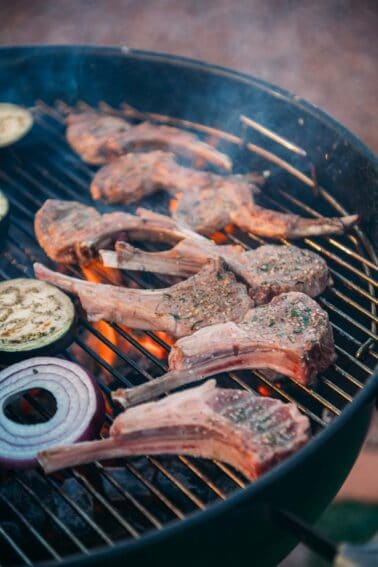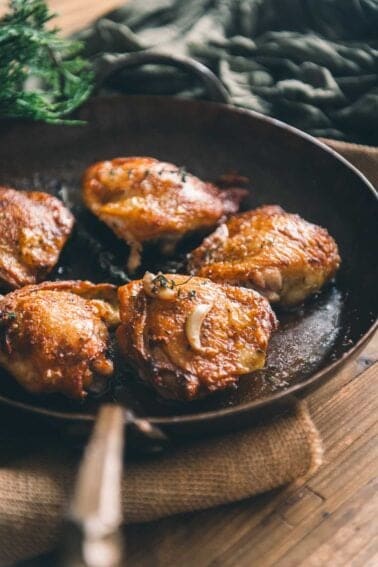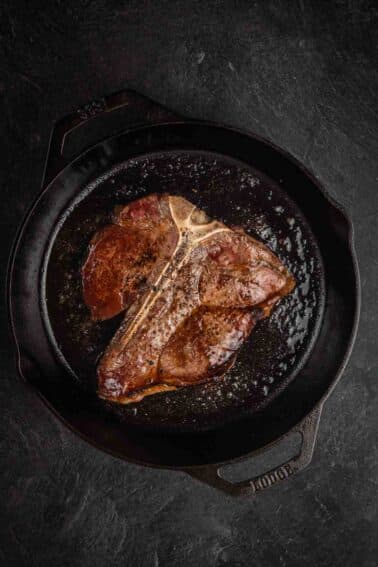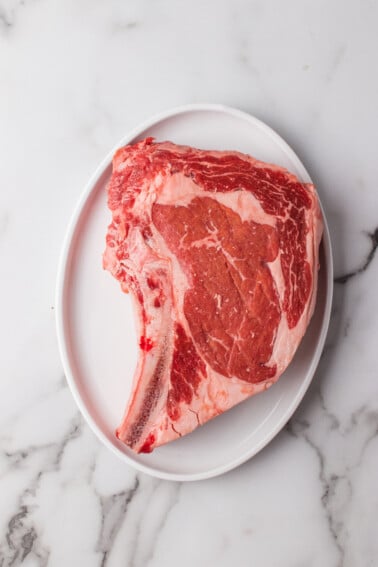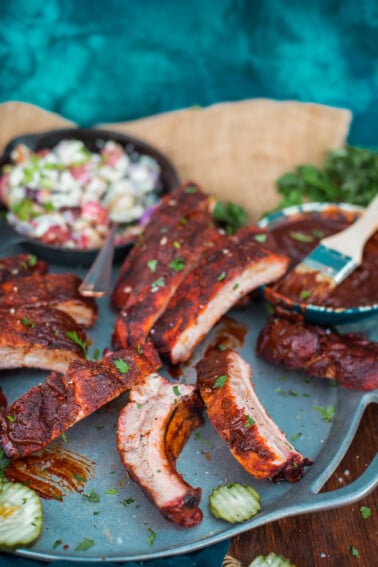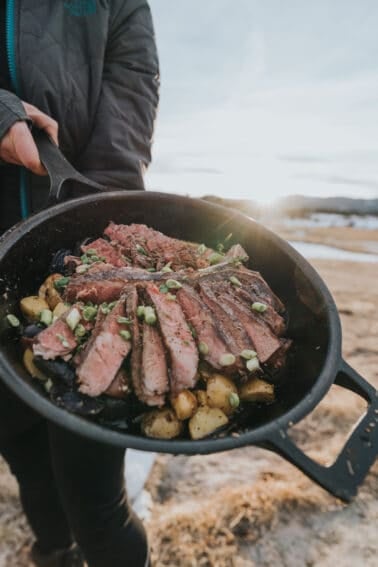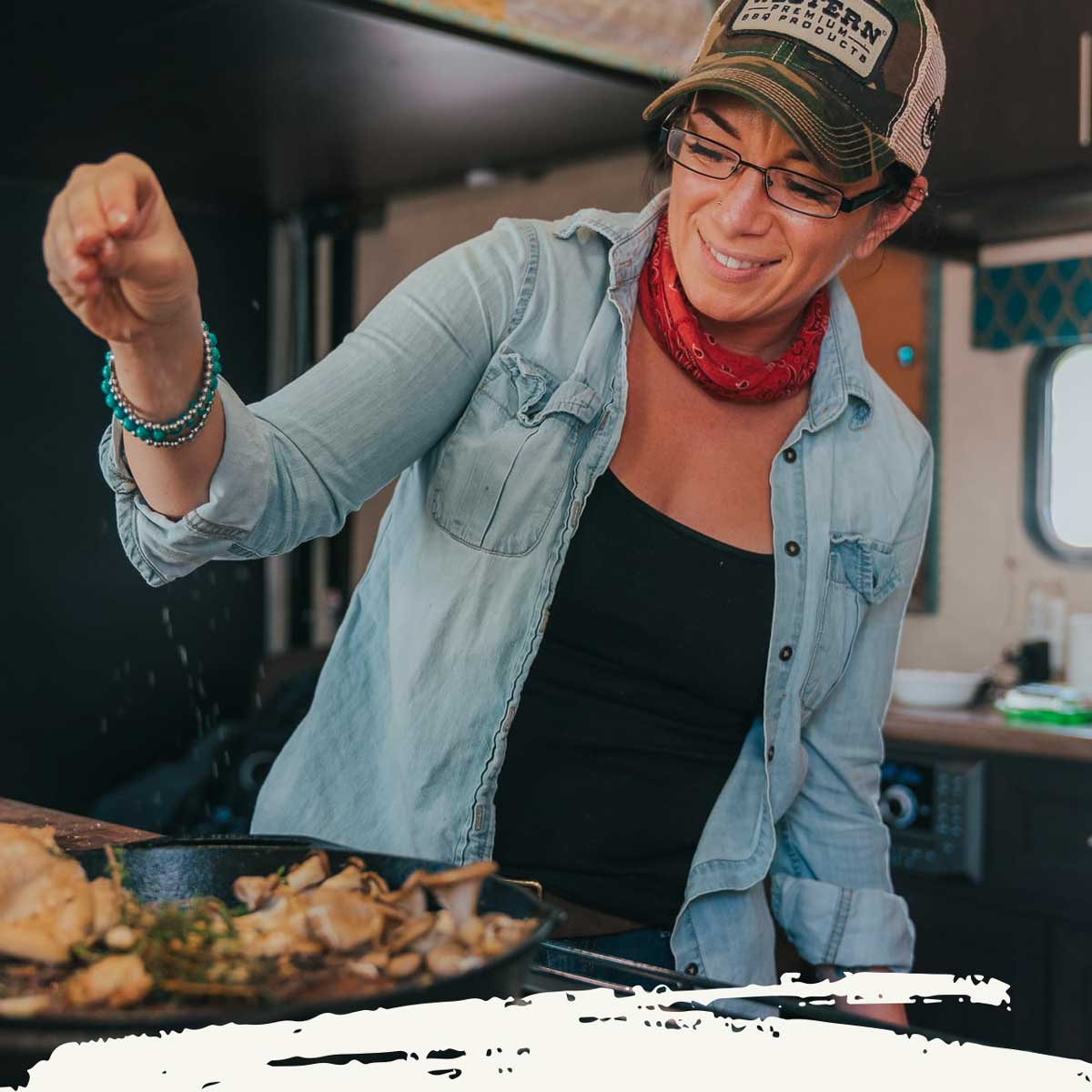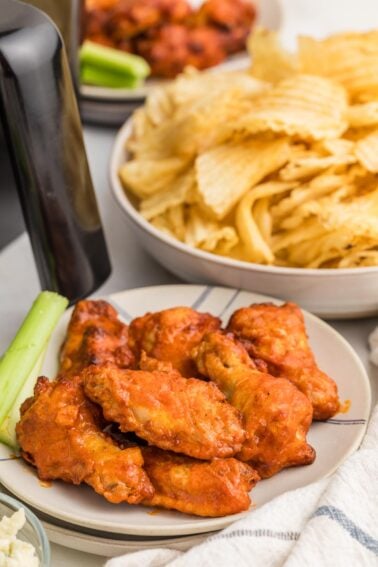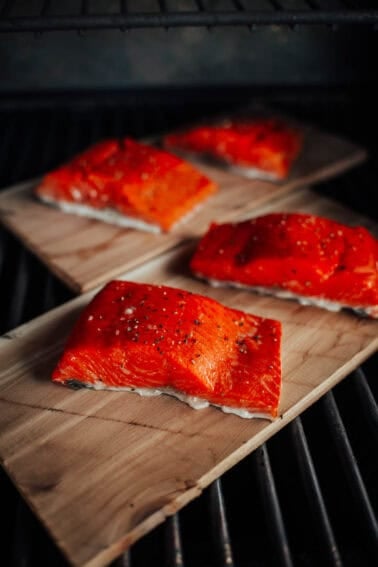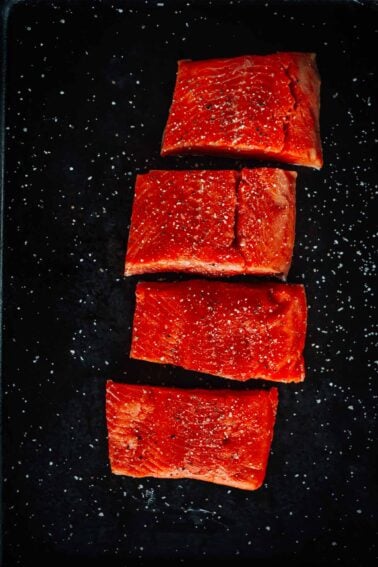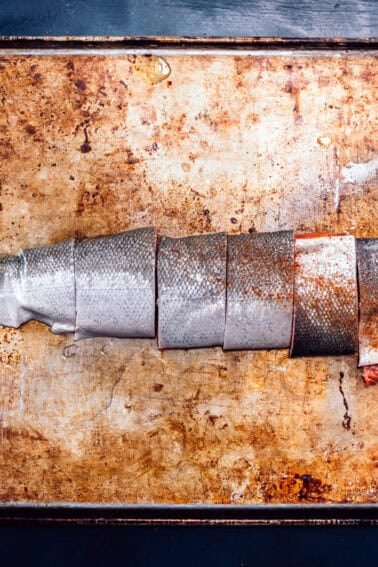If you’ve ever marveled at the edge to edgde crust on your perfectly seared steak or the enticing aroma of freshly baked bread, you’ve experienced the wonders of the Maillard reaction. And we’re about to break down just why that’s so important for your next steak dinner.
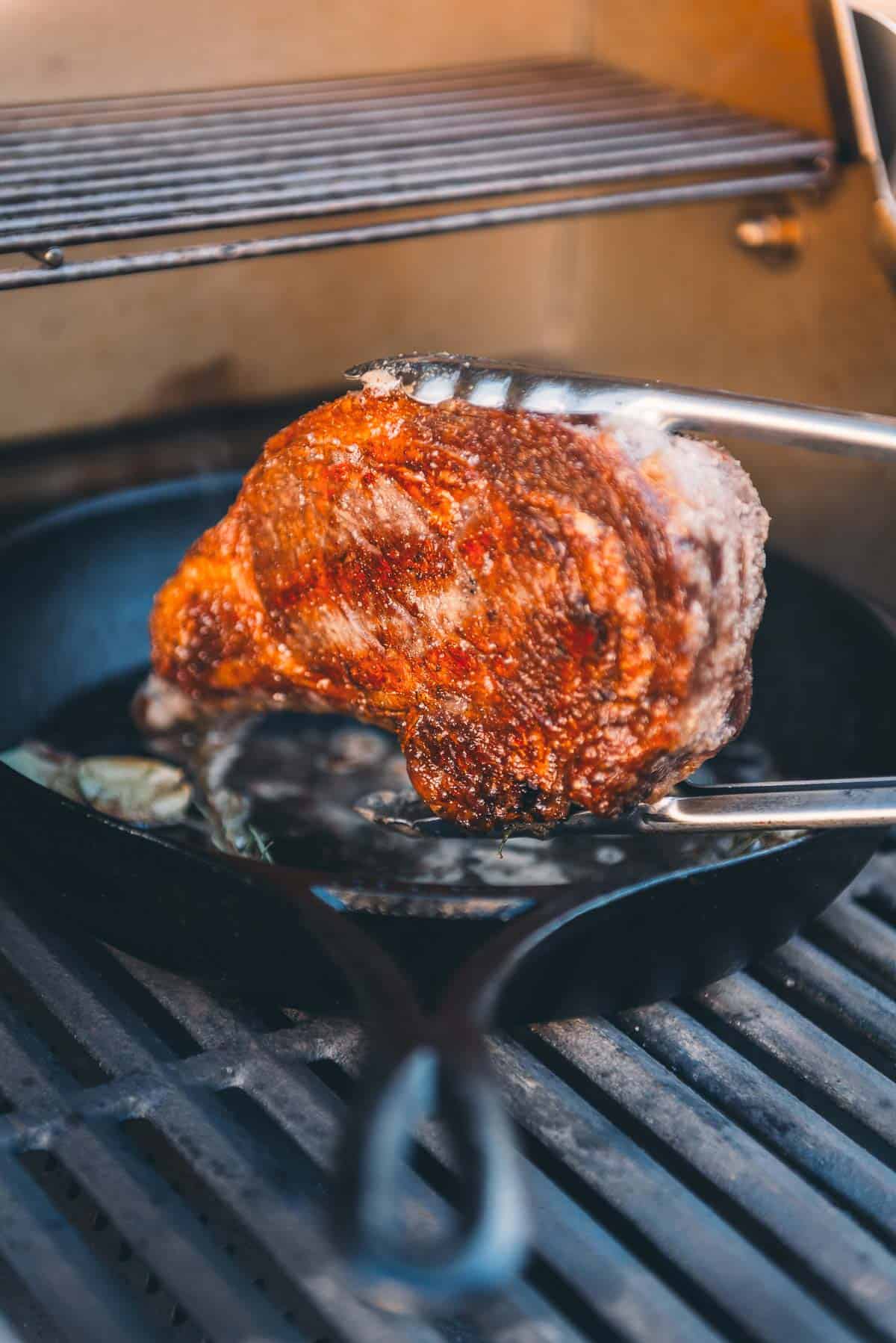
Table of Contents
- TL;DR Summary
- Who came up with the Maillard reaction?
- Understanding the Maillard reaction
- What the Maillard reaction means for Cooking Methods and Flavors
- Our favorite recipes where the sear is essential
- The Best Skillet for Searing
- The Maillard Reaction is more than Meat
- Girl Carnivore Pro Tip
- What the Science Says
- More Cooking Guides and how-to’s for next-level flavor
TL;DR Summary
This is a long science-y post that breaks down what is the Maillard reaction for our MeatNerds and why it’s essential to understand in cooking to create mouthwatering steaks, drool-worthy burgers, and the golden crust on chicken. But if you don’t want to nerd out, here’s the gist of it:
The Maillard reaction is a chemical reaction that occurs between amino acids and reducing sugars when foods are cooked at high temperatures. This browning reaction is what gives seared steaks, roasted chicken, and freshly baked bread their delicious flavor and appetizing color (because we’ve all seen meat right out of the sous vide, and it ain’t pretty).

Slicing through the perfect sear on any type of steak to find a medium rare center is one of the most satisfying moments in the kitchen. For my fellow Meat Nerds, let’s break down why.
The Maillard reaction is a chemical process that happens when amino acids and sugar molecules mix at a high temperature (aka, grilling, searing, roasting, etc), causing food to brown and creating a flavor reaction and aroma compounds. It’s different from caramelization because it involves different amino acids and sugars, giving a wider range of flavors.
Temperature and time play an important role in the Maillard reaction as well. Higher temps speed up the browning process. This reaction is key in cooking, adding taste, color, and texture to lots of foods like meats, bread, veggies, and coffee.
During the Maillard reaction, tons of flavor compounds are made, each adding to the taste. You get savory, nutty, caramel, and roasted flavors that make food even better. Like, in meats, it brings out savory and meaty tastes we talk about when discussing what is umami, and in bread, it gives that nice golden-brown color and nutty flavor.
Who came up with the Maillard reaction?
The Maillard reaction, named after French chemist Louis-Camille Maillard, who first described it in the early 20th century, is a complex chemical reaction that occurs between amino acids and reducing sugar when exposed to heat. This reaction is responsible for the browning and development of delicious flavor in various foods during the cooking, baking, and roasting processes.
Historically, the Maillard reaction was initially observed in the context of food chemistry, particularly in the caramelization of sugars and the browning of bread crusts.
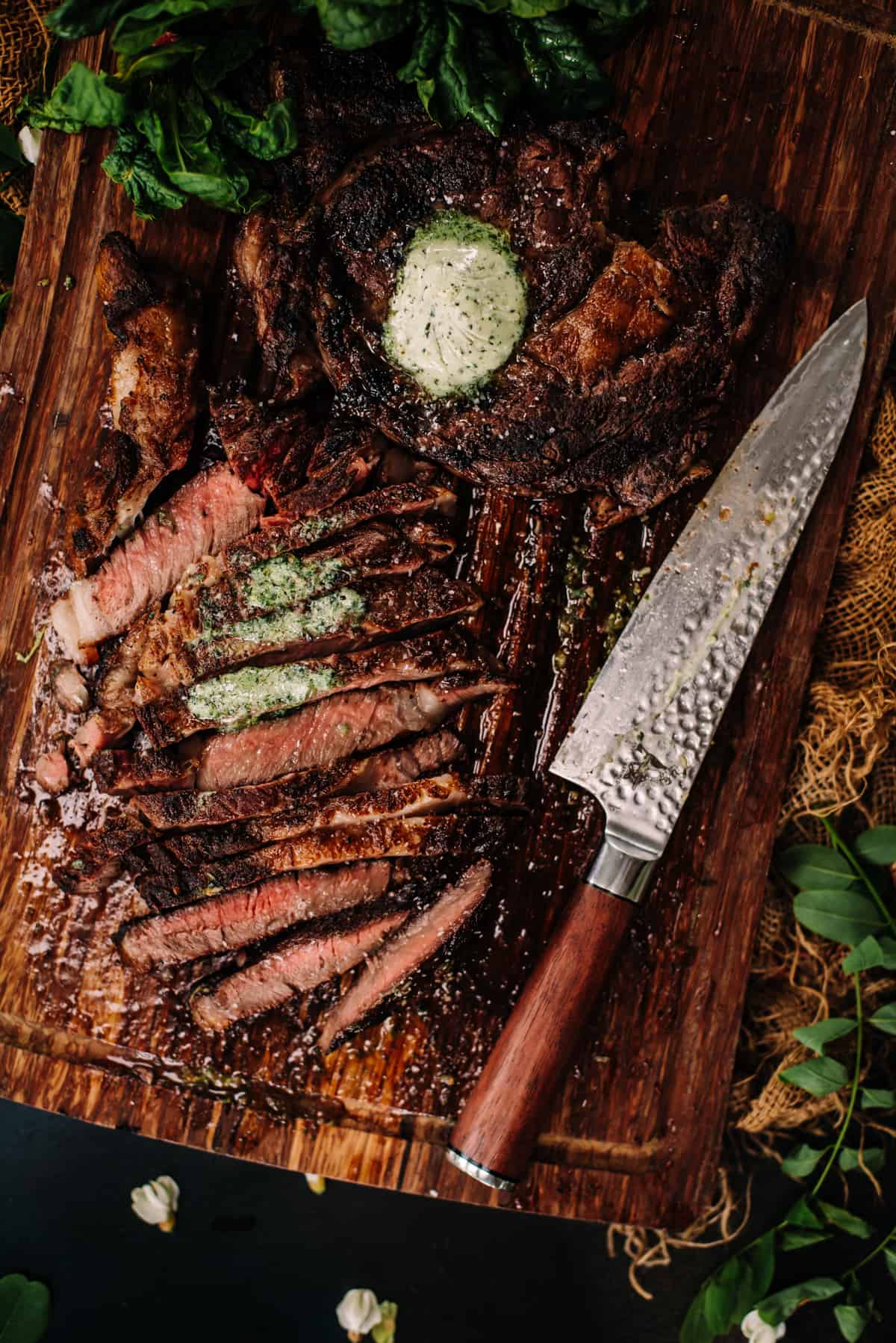
Understanding the Maillard reaction
The Maillard reaction is like a magical chemistry show that happens when amino acids (the building blocks of protein) and reducing sugars (free with the carbonyl group) meet heat.
This reaction creates new flavors through dehydration, condensation, and rearrangement of compounds, giving foods that irresistible taste and color. Amino acids, especially the ones with nitrogen, kickstart this flavorful journey by reacting with sugars to form Maillard reaction products (MRPs). These then transform into melanoidins, the secret behind the mouthwatering richness of Maillard-cooked foods.
Now, let’s talk about temperature and pH levels—those are the Maillard reaction’s best friends. Higher temperatures speed things up, making foods brown beautifully and developing complex flavor profiles. But don’t get too hot-headed; too much heat can ruin the party with unpleasant flavors.
And pH levels? They play a big role, too. Alkaline conditions speed up the Maillard reaction, while acidic ones can take it in a whole new flavor direction. Studies have shown that a pH level of 7 or above can increase the speed of the Maillard reaction.
Comparing the Maillard reaction to caramelization is like comparing two best friends with different styles. While both processes brown food, Maillard brings in amino acids and sugars, while caramelization is a form of non-enzymatic browning involving only simple sugars, giving foods that distinct sweet and nutty taste.
Key Factors Influencing the Maillard Reaction
The Maillard reaction is a versatile chemical process that occurs in a wide variety of foods, contributing to their distinct flavors, aromas, and appearances. Some common examples of foods that undergo the Maillard reaction include:
- Meats: When meat is cooked at high temperatures, the amino acids and sugars present in the protein-rich muscle tissue undergo the Maillard reaction, resulting in the characteristic browning and savory flavors associated with grilled steaks, roasted chicken, and pan-seared pork chops.
- Bread and baked goods: The Maillard reaction plays a crucial role in the formation of the golden crust on bread and pastries. As bread dough is exposed to heat in the oven, the sugars and amino acids in the flour and yeast react, producing a complex array of flavors and aromas that enhance the overall taste and texture of the baked goods.
- Coffee: During the roasting process, coffee beans undergo the Maillard reaction, leading to the development of the rich, caramelized flavors and aromas that coffee lovers crave. The Maillard reaction also contributes to the deep brown color of roasted coffee beans and the brewed coffee itself.
- Chocolate: When cocoa beans are roasted, the Maillard reaction occurs, resulting in the development of the different flavors and aromas that are characteristic of chocolate. This reaction is responsible for the deep, rich flavor profile of dark chocolate.
(Pretty sure we just covered our basic food groups and suddenly understand the thread that ties them together…)
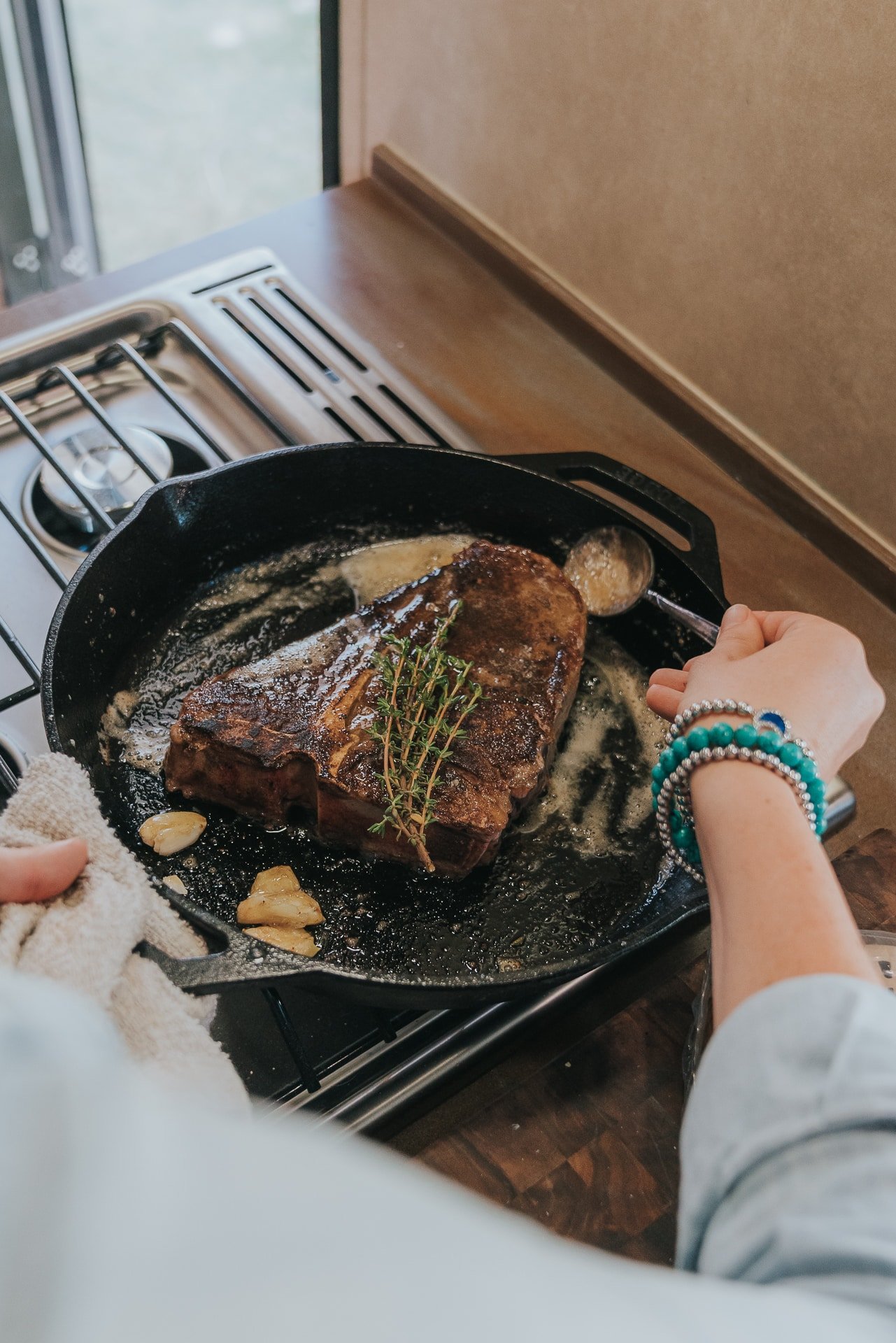
What the Maillard reaction means for Cooking Methods and Flavors
The Maillard reaction is influenced by various cooking methods and techniques, each of which can have a significant impact on flavor development. Some common cooking methods and their effects on the Maillard reaction include:
- Grilling: Grilling exposes food directly to high heat, promotes the Maillard reaction, and results in the formation of a flavorful crust on the exterior of meats and vegetables. For example, grilling a steak exposes it to high heat, beginning the Maillard reaction. The result is a tender, juicy, flavorful steak with a dreamy caramelized crust. In the reverse sear method, the meat is cooked over indirect heat on a two-zone fire and then is placed over high heat to finish the steak, causing the Maillard reaction at the end. And, the crust is just one way to add flavor, but when grilling, adding smoking wood is also a key component to building the layers of flavor that make every bite so good.
- Roasting: Roasting involves cooking food in an oven at high temperatures, allowing the Maillard reaction to occur gradually over time. People often use this method to bring out those delicious, caramelized flavors in meats, veggies, and baked treats, like with our
- Searing: Searing involves cooking food quickly at high temperatures in a hot pan or on a grill. This intense heat promotes the rapid Maillard reaction, resulting in the formation of a savory crust on the surface of foods, like reverse-seared prime rib or pan-seared ribeye steaks.
- Baking: Baking exposes food to indirect heat in an oven, allowing the Maillard reaction to occur slowly over time. People often use this method to create those amazing flavors and smells you find in bread, pastries, and other baked treats.
Tips to achieve the Maillard Reaction like a pro
- Dry your ingredients: Pat meat or vegetables dry with paper towels before cooking to remove excess moisture. The dryer the surface of the meat, the better the sear and browning.
- Preheat your cooking surface: Whether it’s a pan, grill, or oven, ensure it’s fully preheated before adding your ingredients. This helps to kickstart the Maillard reaction from the moment the food touches the surface.
- Don’t overcrowd the pan: When searing or sautéing, avoid overcrowding the pan. This can actually lead to steaming rather than browning. You can sear or saute in batches if needed when working with a lot of food.
- Use the right oil: Choose oils with high smoke points, such as canola, grapeseed, or our favorite, avocado oil, to prevent burning and achieve a good sear.
- Give it time: When searing meat or vegetables, resist the urge to constantly move or flip them. Let them cook undisturbed for a few minutes to promote even browning. A quick way to tell is if the meat will lift easily with a light tug using long tongs. If it is still stuck to the pan, in most cases, the crust hasn’t formed yet. Sometimes, your cast iron may need to be seasoned, or the pan may not be hot enough.
- Utilize high heat: Cooking at higher temperatures can accelerate the Maillard reaction, creating that desirable brown crust and flavor. Most recipes on GirlCarnivore say, ‘Preheat until the pan is just starting to smoke.’ That’s when you know the cast iron is ready to go to work.
Now that you’ve got the knowledge, put it to the test…
Our favorite recipes where the sear is essential
Grilling Recipes
Grilled Lamb Chops
Seafood
Pan Seared Scallops
Dinner Recipes
Easy Pan-Seared Chicken Thighs
Beef Recipes
Perfect Pan-Seared Porterhouse Steak
The Best Skillet for Searing
Our favorite pan for getting the perfect crust on steak recipes is our Carbon steel Smithey skillet. It’s lighter than our cast iron pans, and once it gets hot, the sear is amazing!
Our second favorite pan is our Le Creuset Enamel Coast Cast Iron Skillet. We love this pan and use it daily. It will last lifetimes if seasoned and cleaned properly. However, it is heavy and expensive. But, we think of it as an investment in our kitchen. Ours is over ten years old and is still in great shape.
You can achieve the same results in a much less expensive Lodge Cast Iron Skillet. We have 5 or 6 Lodge skillets in our rotation and they go on camping trips and put through abuse. And they, like the more expensive brand, will last generations if cared for properly.
The Maillard Reaction is more than Meat
Outside of home kitchens, the Maillard reaction is a big deal in the food industry. Food producers utilize this reaction to craft a variety of tasty items, ranging from savory snacks to sweet indulgences.
In baking, the Maillard reaction is super important for getting that perfect color, flavor, and texture in baked goods. Whether it’s getting a nice golden-brown crust on bread or making cookies nice and crispy, bakers use the Maillard reaction to make goodies people can’t get enough of.
In the meat world, the Maillard reaction helps to add a desirable layer to smoked and cured meats, enhancing their unique flavor and color. Aka, it looks pretty.
Nerd out: The Maillard reaction is also a big player in making drinks like beer and whiskey. When grains are roasted and malted, they go through Maillard reactions, giving the final drink lots of complex flavors.
Alternatives to traditional sugars for browning
Traditional recipes often lean on ingredients like sugar and wheat flour to achieve Maillard browning, but with some creative substitutions, similar flavors and textures can be achieved while meeting dietary needs.
In sugar-free diets, alternative sweeteners like erythritol, stevia, or monk fruit extract offer a way to achieve Maillard browning without relying on traditional sugar. Similarly, for gluten-free diets, flours, such as almond flour, coconut flour, or rice flour can be substituted for wheat flour to initiate Maillard reactions in gluten-free recipes.
Always use caution, as sugars burn quicker and can go from a nice sear to acrid quickly.
Girl Carnivore Pro Tip
It’s important to note that the Maillard reaction is a key to producing savory flavors but it’s all a balance. If you have a spiced rubbed dish, it’s important to know that some spices burn at high heat, causing an acrid flavor. Paprika, like in our chicken paprikash recipe, burns when applied to searing hot heat, so it’s better to add it later in the recipe.
When working with cuisines or recipes that use rich spices, it’s important to know when to add them for the best results.
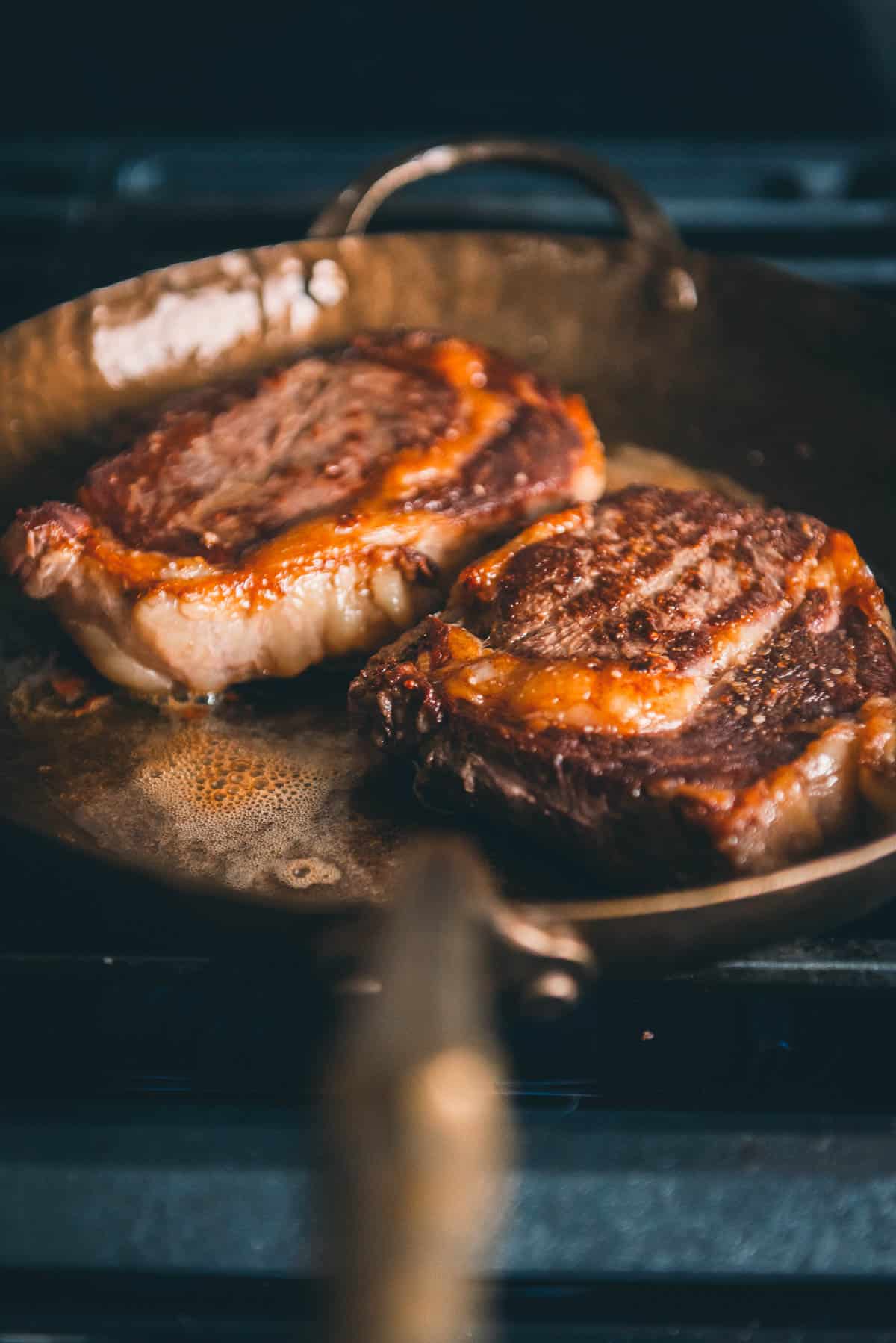
What the Science Says
Recent scientific studies have been digging deep into the mysteries of the Maillard reaction. They’ve uncovered some fascinating stuff, like new amino-acid sugar combos that kickstart specific flavor compounds.
But that’s not all! Scientists have also been geeking out over how the Maillard reaction can keep our food safer and fresher for longer. Turns out, it’s packing some serious antimicrobial properties that might just extend the shelf life of your favorite foods.
And with fancy-schmancy analysis techniques like mass spectrometry and high-performance liquid chromatography, we’re diving even deeper into the Maillard reaction. It’s like we’re unlocking the secrets to making food taste even more amazing.
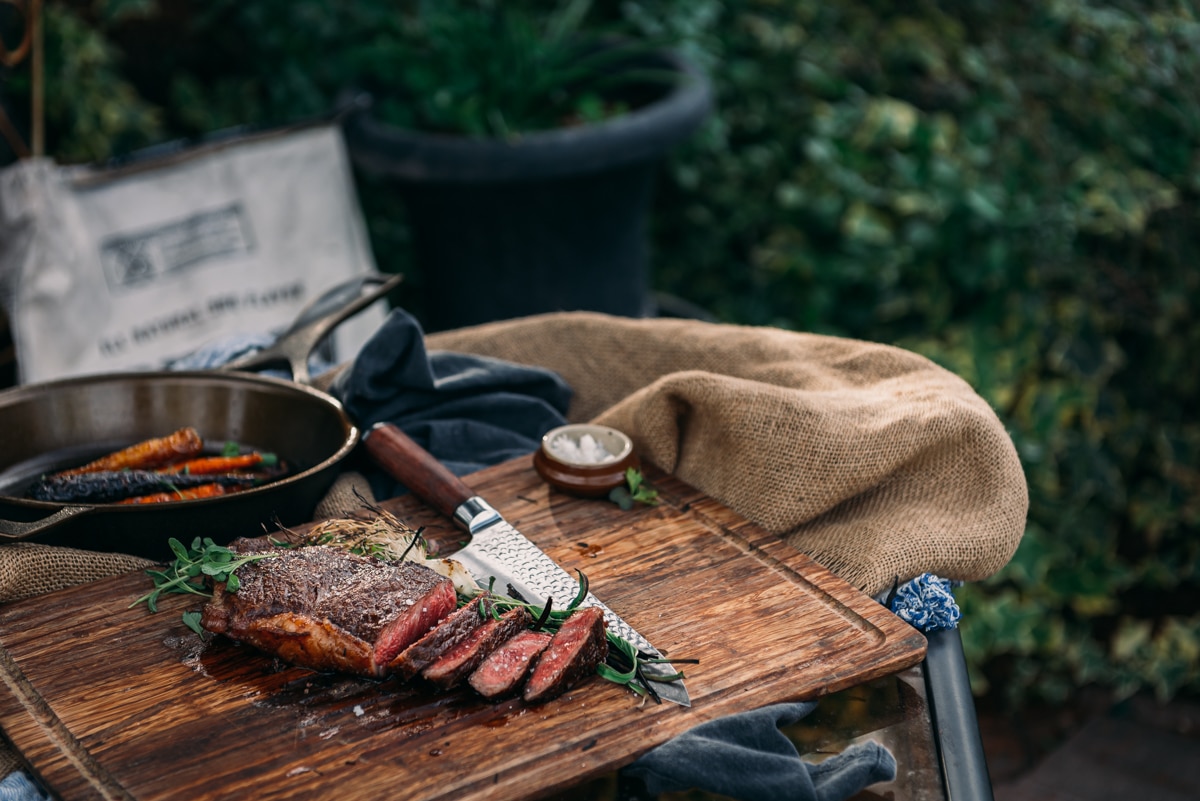
Trends and Innovative Approaches
One of the trends taking the cooking world by storm is using the Maillard reaction with different cooking methods. Using fancy cooking techniques like sous vide and cooking at lower temperatures help guarantee that roasts and cuts turn out perfectly cooked and juicy every time.
But often, they aren’t that appealing to look at. Food right out of the sous vide water bath can be dull in color, despite being perfectly prepared and safe to eat. This is where the Maillard reaction comes in. You’ll notice in all of our sous vide recipes, we start or finish with a sear to get the right flavor vibes and look that make you want to dive in.
The food world is diving into the world of natural ingredients and bioactive stuff like enzymes and prebiotics to jazz up those Maillard reaction pathways. The result? Healthier, tastier food options that’ll blow your taste buds away.
Technology’s getting in on the action, too. With super-smart computational modeling and artificial intelligence leading the charge, we’re about to see a total game-changer in how we create food products and craft flavors.
The potential future applications and implications of the Maillard reaction span across various fields, including food science, nutrition, and sensory research.
In food science, researchers are exploring the use of Maillard reaction products as functional ingredients in food formulations, leveraging their antioxidant, antimicrobial, and flavor-enhancing properties to create healthier and more flavorful products.
All that to say, getting the perfect sear on your steak isn’t just about bragging rights. It’s actually improving your dinner. That crust on your burger is essential to its mouthwatering flavor (which is another reason we all love a good smash burger). The crisp on your carnitas… no, wait. That’s actually caramelization, but you’re getting the idea.
The Maillard reaction is more than a fancy term for browning food. It’s one of the most important flavor-producing reactions that can take your food from inedible to incredible. The browning reaction is what makes food taste so good, from a seared steak to roasted coffee beans to delicious pastries. Understanding the Maillard reaction is essential for optimizing flavor development in cooking, and now you know why. Now, put that new knowledge to the test.
